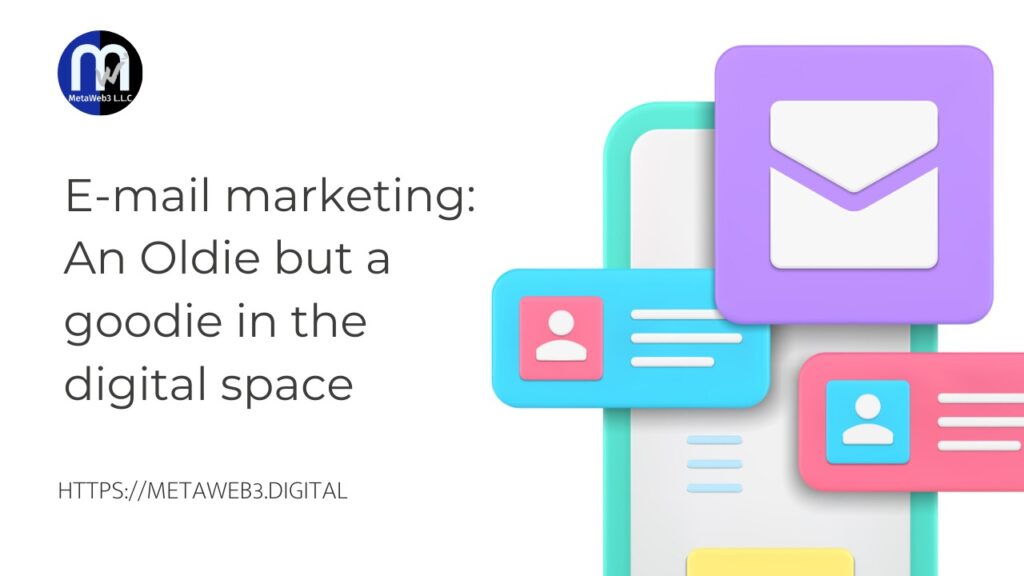
Table of Contents
Introduction
Welcome to Metaweb3’s official blog, where we dive deep into the dynamic world of email marketing. In an era dominated by ever-evolving digital landscapes, email marketing remains a stalwart strategy that connects brands with their audiences in meaningful ways. Our blog is your one-stop destination for expert insights, tips, and techniques that will help you harness the power of email marketing to drive engagement, conversions, and brand growth. Whether you’re a seasoned email marketer or just starting your journey, our blog empowers you with the latest trends and best practices in this ever-critical facet of digital marketing. Let’s explore the art and science of email marketing, from crafting compelling content to optimizing your campaigns for exceptional results.
Fundamentals of Email marketing:
What Is Email Marketing?
Email marketing is a digital marketing strategy that involves sending targeted messages and content to a list of subscribers via email. Its primary role is to connect with the audience by nurturing relationships, building brand awareness, and driving conversions. It enables businesses to deliver personalized content, promotions, and information directly to the inboxes of interested recipients, fostering customer engagement. Email marketing can also segment audiences for tailored communication, track performance through analytics, and facilitate two-way communication, making it a cost-effective and efficient tool for building and maintaining customer relationships.
Types of Email Campaigns
- Promotional Campaigns–These focus on discounts, product launches, or special offers to encourage sales.
- Newsletter Campaigns – Periodic updates or news about a brand, industry, or niche to inform and engage subscribers.
- Welcome Campaigns -Sent to new subscribers to introduce the brand, set expectations, and establish a relationship.
- Transactional Campaigns – Include order confirmations, shipping notifications, and other transaction-related emails.
- Survey or Feedback Campaigns – Seek customer input and feedback to improve products, services, and customer experience.
Why Email Marketing Matters?
Email marketing matters because it provides a direct and personal connection with your audience, fostering trust and loyalty. It offers a high return on investment (ROI) and measurable results, making it a cost-effective and data-driven marketing strategy. Email campaigns can nurture leads, convert prospects, and retain customers, contributing significantly to revenue generation. With segmentation and personalization, businesses can send tailored content, ensuring relevance and engagement. In a digital age, email marketing remains a vital channel for building and maintaining customer relationships, enhancing brand visibility, and driving conversions.
Benefits of Email Marketing:
- Audience Data Insights: Beyond just delivering messages, email marketing collects valuable data on subscriber behavior, preferences, and engagement. This unsaid benefit allows businesses to gain deep insights into their audience, helping shape product development, content strategies, and overall marketing efforts. By analyzing open rates, click-through rates, and conversion metrics, companies can continually refine their understanding of their audience’s needs and tailor their offerings to meet those needs more effectively.
- Lead Nurturing and Long-term Relationships: Email marketing often focuses on more than just immediate sales. It excels at nurturing leads and guiding prospects through their decision-making process. While this isn’t usually the primary stated goal, it’s one of the unsung benefits of consistent email communication. By providing ongoing value and relevant content, businesses can build trust and form long-term relationships with subscribers, resulting in customer loyalty and repeat business over time.
- Reactivating Dormant Customers: Another unspoken advantage is the ability to revive dormant or lapsed customers. Email campaigns explicitly designed for re-engagement can rekindle interest, bring back customers who might have forgotten about your brand, and even win back those who may have opted out. It’s a cost-effective way to regain business from a previously engaged segment.
- Testing Ground for Marketing Strategies: Email marketing can be a testbed for various marketing strategies, from content messaging and offers to design and calls to action. These tests can inform broader marketing initiatives, optimizing performance across multiple channels. The subtle, ongoing experimentation can lead to more effective strategies and campaigns in other areas of a business’s marketing efforts.
- Brand Loyalty and Advocacy: While building brand loyalty is an overarching marketing goal, the role email marketing plays in cultivating brand advocates who often need to be more public. Satisfied subscribers can become vocal supporters, referring friends and family and spreading positive word-of-mouth. These brand advocates can significantly boost your business through their endorsements, and email marketing keeps them engaged and informed so that they continue to champion your brand.
Building a Strong Foundation in Email Marketing
Understanding Your Audience
Audience segmentation and personalization are indispensable in modern marketing strategies. You can craft tailored messages that resonate personally by breaking your audience into distinct, well-defined groups based on various characteristics like demographics, behaviors, and preferences. This approach is crucial because it ensures that your communication is relevant and engaging and directly addresses each segment’s unique needs and interests. Personalization, in particular, creates a sense of connection and trust, conveying that you understand and care about your audience’s preferences. These strategies improve the effectiveness of marketing efforts, increase open and conversion rates, and foster lasting customer relationships, driving loyalty and ultimately contributing to business success in an increasingly competitive digital landscape.
Building a Quality Email List
Growing your subscriber list more organically is essential for effective email marketing. To do so, optimize your website and content to encourage sign-ups. Implement prominent and visually appealing email capture forms on crucial pages and offer incentives like exclusive content, discounts, or free resources to entice visitors to subscribe. Leverage social media and other online channels to promote your email newsletter and reach a wider audience. Collaborate with complementary businesses for cross-promotion, and always maintain transparency by clearly communicating what subscribers can expect regarding email frequency and content. Regularly deliver valuable and relevant content to keep existing subscribers engaged and encourage them to refer others. Lastly, consider leveraging user-generated content and testimonials to build trust and credibility, making visitors more likely to become loyal subscribers.
Crafting Compelling Subject Lines and Design Best Practices
The art of creating attention-grabbing subject lines lies in piquing the recipient’s curiosity while being concise and relevant. A well-crafted subject line should glimpse what’s inside: an intriguing question, a sense of urgency, or a benefit-driven statement. The key is to strike a balance between being engaging and not resorting to clickbait. Once the subject line entices the recipient and opens the email, delivering equally engaging content is challenging, which involves keeping the message concise, offering value, and having a clear call to action. Successful email content should speak directly to the recipient’s interests, needs, or pain points, fostering a connection and increasing the chances of conversions or desired actions.
Email Sending Frequency
Finding the right balance for your audience is a delicate yet crucial aspect of email marketing. It entails striking the perfect equilibrium between staying top-of-mind and avoiding overwhelming your subscribers. Consistency in email frequency is key; send emails often enough to maintain engagement but not so frequently that you risk unsubscribing due to email fatigue. It’s essential to listen to your audience’s feedback and monitor their engagement metrics to gauge their preferences. By understanding their tolerance and interests, you can tailor your email schedule and content to align with what resonates best with your subscribers, ultimately nurturing stronger, longer-lasting customer relationships.
Email Marketing Automation
Automating email campaigns offers a multitude of benefits for businesses. First and foremost, it saves time and resources by streamlining sending emails to targeted audiences. Automation allows for delivering timely and personalized content, increasing relevance and engagement. It also enables the nurturing of leads and maintaining consistent communication, helping to guide prospects through the sales funnel. Additionally, automation tools provide in-depth analytics, allowing marketers to track performance, measure results, and make data-driven improvements for better campaign effectiveness. Ultimately, by automating email campaigns, businesses can boost efficiency, drive better outcomes, and enhance the overall customer experience.
Conclusion
Email marketing is a versatile tool that offers a direct line of communication, and when executed with precision, it can deliver remarkable results. As we wrap up this journey through the art of email marketing, remember that the key to success lies in understanding your audience, crafting compelling content, and staying agile in the face of shifting trends. At Metaweb3, we’re here to help you harness the full potential of email marketing, providing tailored strategies and expert guidance to propel your campaigns to new heights. We invite you to reach out and embark on this transformative journey with us, where together, we’ll navigate the ever-changing digital landscape and unlock the limitless possibilities that email marketing holds.

